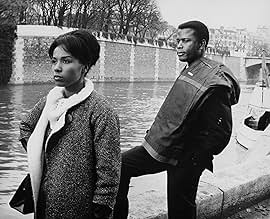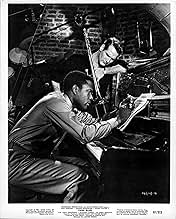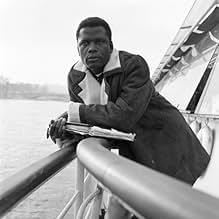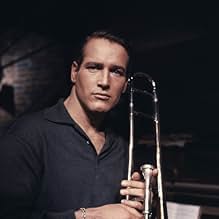IMDb-BEWERTUNG
6,7/10
4348
IHRE BEWERTUNG
Während der 1960er-Jahre verlieben sich zwei amerikanische Jazzmusiker, die in Paris leben, in zwei amerikanische Touristinnen.Während der 1960er-Jahre verlieben sich zwei amerikanische Jazzmusiker, die in Paris leben, in zwei amerikanische Touristinnen.Während der 1960er-Jahre verlieben sich zwei amerikanische Jazzmusiker, die in Paris leben, in zwei amerikanische Touristinnen.
- Für 1 Oscar nominiert
- 2 Nominierungen insgesamt
Guy Pedersen
- Bass Player
- (as Guy Pederson)
Emilien Antille
- Alto Sax Player with Armstrong at Club 33
- (Nicht genannt)
Roger Blin
- Guitarist Fausto the Moor
- (Nicht genannt)
Charles Bouillaud
- Luggage Carrier in Train
- (Nicht genannt)
Michel Dacquin
- Guest at Devigne's Party
- (Nicht genannt)
Hélène Dieudonné
- The Pusher
- (Nicht genannt)
Michel Garland
- Club 33 Customer
- (Nicht genannt)
Empfohlene Bewertungen
The American in Paris theme has been done very often in American cinema. The tradition is huge splashy technicolor with Gene Kelly, Fred Astaire, Jane Powell, Audrey Hepburn cavorting around the well known streets and landmarks. Those are nice films, but that ain't what you get here.
No Louvre, no Arc de Triomphe, no Eiffel Tower, a brief shot of Notre Dame from a distance; that's about it from the well known Paris. The Paris we see here in this black and white film is of the jazz clubs of the Left Bank where two expatriate musicians, Paul Newman and Sidney Poitier, eke out a living doing what they love.
Newman has ambitions though, he'd like to be a serious composer not a trombonist all his life. Poitier has come to Paris for reasons of the race problems in the USA.
Into their lives two American tourists come, Joanne Woodward and Diahann Carroll. A couple of dual romances commence.
Carroll and Poitier have a spirited debate over civil rights. The movement is getting into high gear in America and Carroll wants him to return and be part of it. No thanks, says Poitier, he just wants to do his jazz thing where his skin color isn't anyone's problem least of all his own.
Interestingly Carroll was doing a kind of warm up for another part of a black woman in Paris on Broadway the following year in Richard Rodgers, No Strings. In that play she falls for an expatriate writer played by Richard Kiley. An interracial romance, one of the first shown on the Broadway stage, still a lot of the same issues were in that show.
Paris Blues is a different slice of Parisian life for an American film to explore. All four leads do just fine, though the film probably doesn't rank in the top work of any of them.
Lots of jazz music for the aficionado. And of course the presence of the incomparable Louis Armstrong. The highlight of the film is the jam session with those two ersatz musicians Newman and Poitier.
The way Satchmo is received by the public only proves the truth of that line he sang in High Society about the way the French love American jazz.
No Louvre, no Arc de Triomphe, no Eiffel Tower, a brief shot of Notre Dame from a distance; that's about it from the well known Paris. The Paris we see here in this black and white film is of the jazz clubs of the Left Bank where two expatriate musicians, Paul Newman and Sidney Poitier, eke out a living doing what they love.
Newman has ambitions though, he'd like to be a serious composer not a trombonist all his life. Poitier has come to Paris for reasons of the race problems in the USA.
Into their lives two American tourists come, Joanne Woodward and Diahann Carroll. A couple of dual romances commence.
Carroll and Poitier have a spirited debate over civil rights. The movement is getting into high gear in America and Carroll wants him to return and be part of it. No thanks, says Poitier, he just wants to do his jazz thing where his skin color isn't anyone's problem least of all his own.
Interestingly Carroll was doing a kind of warm up for another part of a black woman in Paris on Broadway the following year in Richard Rodgers, No Strings. In that play she falls for an expatriate writer played by Richard Kiley. An interracial romance, one of the first shown on the Broadway stage, still a lot of the same issues were in that show.
Paris Blues is a different slice of Parisian life for an American film to explore. All four leads do just fine, though the film probably doesn't rank in the top work of any of them.
Lots of jazz music for the aficionado. And of course the presence of the incomparable Louis Armstrong. The highlight of the film is the jam session with those two ersatz musicians Newman and Poitier.
The way Satchmo is received by the public only proves the truth of that line he sang in High Society about the way the French love American jazz.
Paris Blues (1961)
*** (out of 4)
American Jazz musicians Ram (Paul Newman) and Eddie (Sidney Poitier) are living in Paris where they spend all night practicing their music. Americans Lillian (Joanne Woodward) and Connie (Diahann Carroll) find themselves in Paris on vacation and soon they meet the musicians and sparks fly. The two week vacation soon has Lillian having major feelings for Ram but he knows if he decides to go with her it would mean going away from his love of music.
Paris BLUES comes from director Martin Ritt who made a number of films with Newman but this one here has to be the most underrated. I really don't understand why this film isn't better known because it features a terrific cast and has some outstanding music as well as being a lot more sexual and mature than a lot of films made during this period.
The main reason to watch this are for the performances and especially the chemistry of Newman and Woodward. The couple was already married by the time they made this and that chemistry between them just jumps right off the screen and especially the sexual tension between the two. Newman is very good in his rather grumpy role and he nails that part perfectly but he also nails the romantic side. Poitier is basically playing second fiddle here but it's still a lot of fun seeing him and Newman work together. Carroll is excellent in her supporting role and it was a lot of fun seeing Louis Armstrong.
The Jazz music score is perfect and I thought the film did a terrific job at playing up the Paris nightlife and the life of two musicians who are up all night. I thought the four stars had an excellent chemistry together and it makes for their journey to be quite entertaining. It also doesn't hurt that the film also deals with race relations without beating the viewing over the head. Paris BLUES really deserves to be seen by more people as it's certainly a nice little gem.
*** (out of 4)
American Jazz musicians Ram (Paul Newman) and Eddie (Sidney Poitier) are living in Paris where they spend all night practicing their music. Americans Lillian (Joanne Woodward) and Connie (Diahann Carroll) find themselves in Paris on vacation and soon they meet the musicians and sparks fly. The two week vacation soon has Lillian having major feelings for Ram but he knows if he decides to go with her it would mean going away from his love of music.
Paris BLUES comes from director Martin Ritt who made a number of films with Newman but this one here has to be the most underrated. I really don't understand why this film isn't better known because it features a terrific cast and has some outstanding music as well as being a lot more sexual and mature than a lot of films made during this period.
The main reason to watch this are for the performances and especially the chemistry of Newman and Woodward. The couple was already married by the time they made this and that chemistry between them just jumps right off the screen and especially the sexual tension between the two. Newman is very good in his rather grumpy role and he nails that part perfectly but he also nails the romantic side. Poitier is basically playing second fiddle here but it's still a lot of fun seeing him and Newman work together. Carroll is excellent in her supporting role and it was a lot of fun seeing Louis Armstrong.
The Jazz music score is perfect and I thought the film did a terrific job at playing up the Paris nightlife and the life of two musicians who are up all night. I thought the four stars had an excellent chemistry together and it makes for their journey to be quite entertaining. It also doesn't hurt that the film also deals with race relations without beating the viewing over the head. Paris BLUES really deserves to be seen by more people as it's certainly a nice little gem.
10rps-2
For starters, this is one of those rare movies that would not have been as good if it had been shot in colour. B&W somehow fits the mood, the story and the setting. Yet it's not really a sad or dark story. As in many older B&W films, the lighting is magnificent with highlights and shadows and textures that simply aren't workable in colour. The performances are universally superb. The script is free of the usual clichés. And the music is great. (How could you possibly make a bad movie with the likes of Louis Armstrong, Paul Newman, Joanne Woodward, Sidney Poitier and Diane Carrol?) Nor, in that era (1961), did Hollywood zoom in and linger obsessively on sexual acrobatics. This is a mature, sexy film without any graphic sex. Those were the rules back then and this film is the better for them. A thoroughly enjoyable movie with a great cast that has stood the test of a half century very well indeed.
PARIS BLUES won't change your life unless you were one of those people (and I count myself one of them) that has been teetering on the verge of Euro-philia and this is the final straw to make you sell off all that crap you've acumulated over the years and live like a peddler just to be in Paris. Even if you are not, this movie could make you think twice. The core of the film is basically by-rote romances that, in themselves, would be non-descipt except for the fact that nothing Paul Newman touches can be bland. It is the elements surrounding these two romances that makes the film worth watching. Generally, to be a watchable film, the sum of the parts have to add up to more than the whole. Here, the film is simply the sum of it's parts...and those parts are wonderful. If I was to tell somebody there was a film out there where Paul Newman romances Joanne Woodward in a fifties jazz club in Paris alongside Sidney Pointier while they compete with Louis Armstrong most would go "What?Where? What movie?" which was exactly my reaction. Paris, Jazz, coffee...Newman. It's a confection with absolutely no nutritional value and yet you feel so much better having tried it.
this movie has been mischaracterized as a fluffy love story, it is not. this film examines racial equality and the differences between France and the us in accepting people of color as more than "help" or as something to fear. this film also touches on the popularity of jazz music, and showcases authentic early jazz as well as painting a picture of the hip jazz subculture, including smoky clubs, late nights and loose women. the film also shows the journey of young musicians trying to find their style and find a place for themselves as jazz composers- not just as musicians. finally, this movie does reflect aspects of a love story- but in examining the film on a deeper level one finds that there really is no love, rather it is a commentary on disconnected, self-indulgent lust. finally - Louis Armstrong appeared and played in the movie- Does it get any better?
Wusstest du schon
- WissenswertesPaul Newman was coached in playing the trombone by Billy Byers, while the playing for Newman on the soundtrack was done by Murray McEachern. Sidney Poitier's tenor sax playing was done by Paul Gonsalves. The soundtrack was recorded May 1-3, 1961 at Reeves Sound Studios in New York City.
- PatzerSome may believe that the mouthpiece ligature on the tenor saxophone that Eddie Cook (Sidney Poitier) plays is upside down. However, in the first scene when the band is playing, it can be seen that the thumbscrew that adjusts the ligature is on the bottom, where it normally would be. It is, therefore, not upside down.
- Crazy Credits"Introducing" Serge Reggiani, who by 1961 had been in French films for 20 years and a star at least throughout the 1950s.
- VerbindungenFeatured in A Century of Black Cinema (2003)
- SoundtracksTake The 'A' Train
(uncredited)
Music by Billy Strayhorn
Recorded at Reeves Sound Studios, New York on May 2 & 3, 1961.
Label - United Artists
Top-Auswahl
Melde dich zum Bewerten an und greife auf die Watchlist für personalisierte Empfehlungen zu.
- How long is Paris Blues?Powered by Alexa
Details
Box Office
- Bruttoertrag in den USA und Kanada
- 1.300.000 $
- Laufzeit
- 1 Std. 38 Min.(98 min)
- Farbe
- Seitenverhältnis
- 1:66
Zu dieser Seite beitragen
Bearbeitung vorschlagen oder fehlenden Inhalt hinzufügen

































